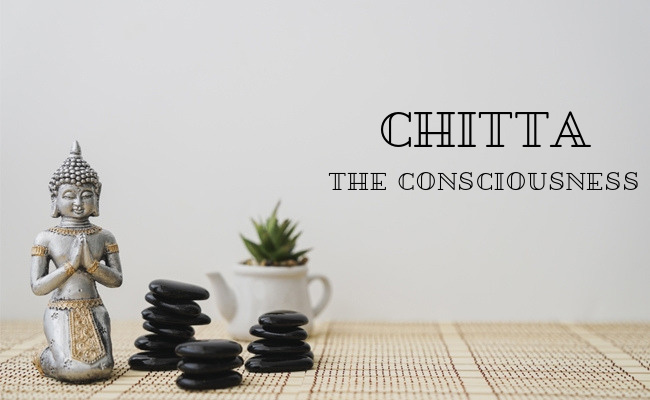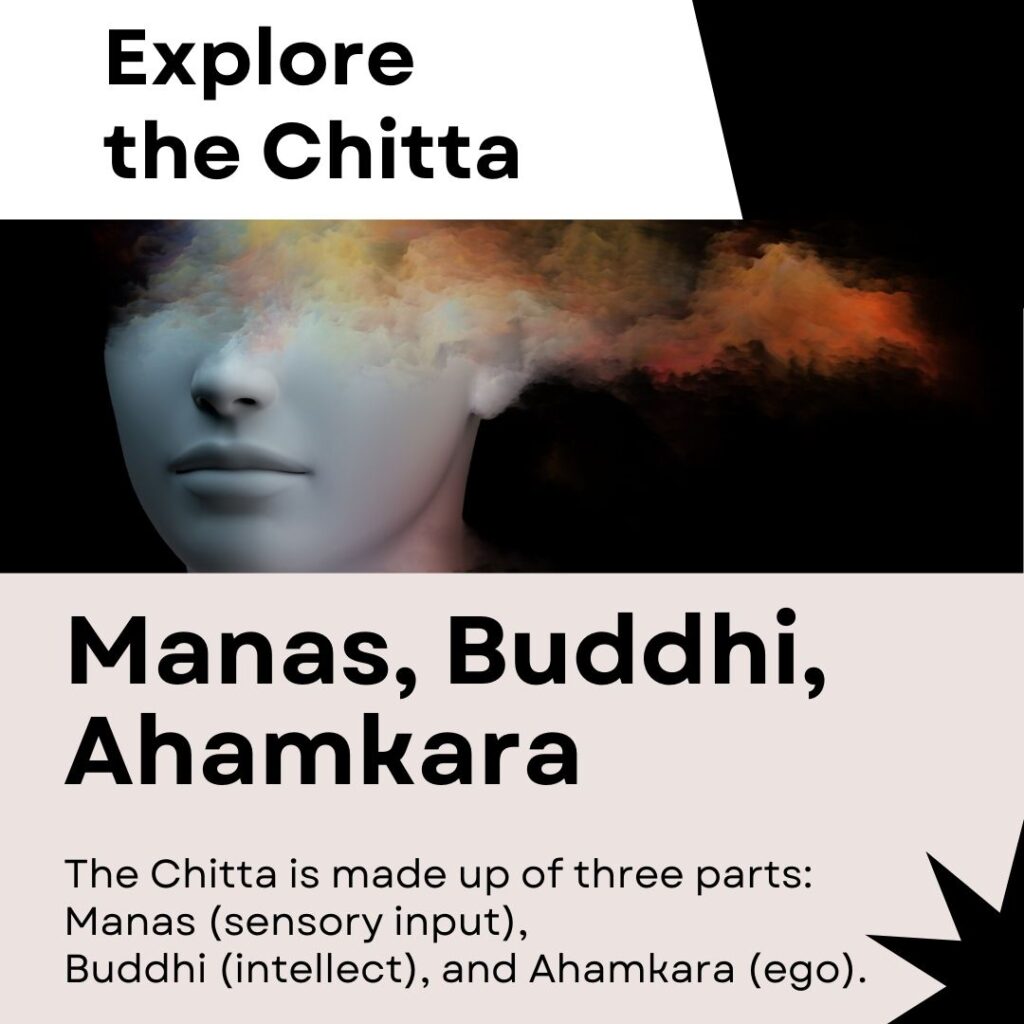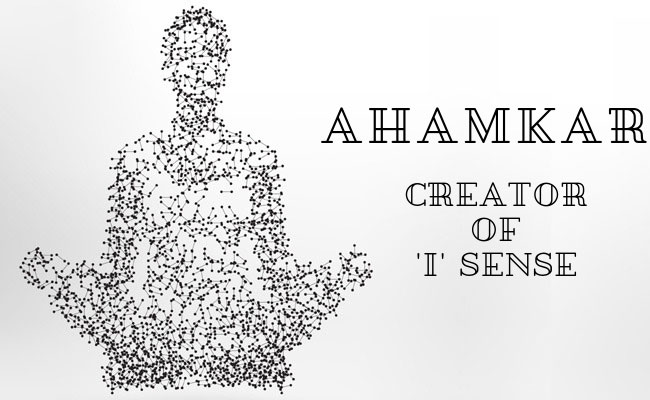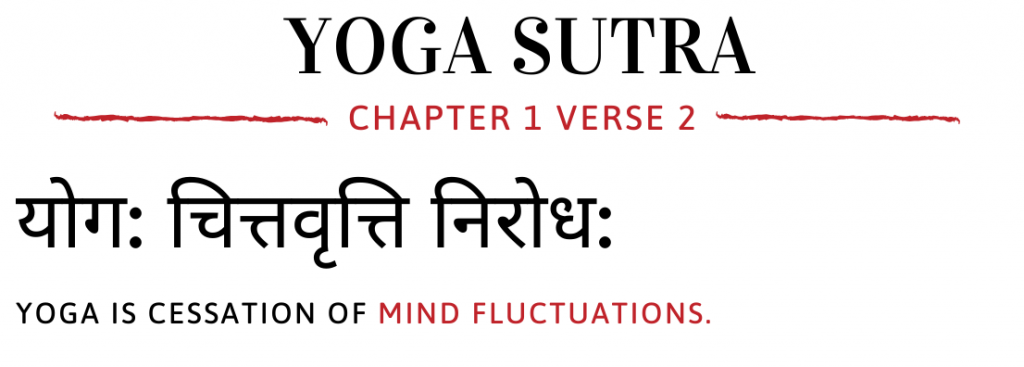
When you’re a devoted yoga practitioner or somebody with a deep understanding of yoga philosophy, you’ve probably come throughout the profound phrase: “Yoga Chitta Vritti Nirodha.”
This phrase, also known as a ‘sutra,’ holds nice significance on the planet of yoga. It’s the second aphorism out of the 196 contained within the Yoga Sutra of Patanjali, some of the revered texts in yoga philosophy.
“Yoga Chitta Vritti Nirodha” encapsulates the essence of yoga apply, providing a profound perception into its objective and potential. However what does it actually imply? How does it relate to the advanced panorama of the thoughts and consciousness? And why ought to it matter to you as a yoga fanatic?
On this article on “Chitta” (additionally spelled as Citta in English), we’ll dive deep into the core of yoga philosophy, exploring the character of the thoughts, its parts, and the way yoga apply can rework it.
Understanding chitta which means
On the coronary heart of yoga philosophy, Chitta (or Citta) refers to consciousness—the very power that shapes our experiences and perceptions. It represents the thoughts, ideas, feelings, and, in essence, the metaphysics of our psychological panorama. Chitta is the canvas upon which the artwork of yoga is painted, and it holds the important thing to understanding our consciousness.
At its core, Chitta is extra than simply the thoughts; it encompasses your complete spectrum of our psychological realm. It’s the repository of our ideas, reminiscences, feelings, and the numerous fluctuations that come up inside our interior world. To actually grasp the profound nature of yoga, one should first come to phrases with Chitta and its position in our journey towards self-realization.
Chitta in yoga philosophy
In yoga philosophy, Chitta is the important thing to understanding the thoughts. It helps us discover how our consciousness connects with the broader universe and the way the three qualities of nature Sattva (purity), Rajas (exercise), and Tamas (inertia) affect our ideas and actions.
These three qualities are the constructing blocks of Chitta, each in us and within the universe at giant. They play a pivotal position in shaping our personalities, influencing our habits, and immediately impacting our psychological states. Simply because the universe consists of those qualities, so too is Chitta, making it our supply of consciousness.
- Sattva guna – The standard of purity and concord within the thoughts.
- Rajas guna – The standard of exercise and restlessness within the thoughts.
- Tamas guna – The standard of inertia and darkness within the thoughts.
Variability of chitta
One of the fascinating elements of Chitta is its continually altering nature. The steadiness of Sattva, Rajas, and Tamas inside Chitta shifts over time, influencing our habits, perceptions, and mind. At occasions, we could really feel lively, curious, and engaged (Sattva); at different occasions, we could expertise lethargy and inertia (Tamas). The interplay of those qualities inside Chitta shapes each our interior and outer experiences.
Understanding the fluctuations of Chitta is essential in yoga apply. It explains why some days we could really feel drawn to intense bodily asanas, whereas on different days, deep meditation or introspection feels extra interesting. Chitta serves because the compass of our yoga journey, and by recognizing its shifts, we achieve helpful perception into the ebb and move of our interior world.
3 parts of chitta

1. Manas: The thoughts’s Tapestry
Manas, also known as the “thoughts,” is the foundational instrument inside Chitta. It acts because the bridge between our interior and outer worlds, enabling us to course of sensory info, ideas, and feelings. Consider it because the lens by way of which we understand actuality.
The Position of Manas
- Manas governs our exterior sensory methods, amassing uncooked information from our environment by way of the 5 senses: sight, sound, scent, style, and contact.
- It’s answerable for perceiving objects and recognizing ideas and feelings, whether or not moments of pleasure or sorrow.
Within the Yoga Sutras, the facility of Manas is claimed to lie in its potential to manage itself, whereas the sensory methods (imaginative and prescient, listening to, scent, style, and contact) are known as the “psyche” or “Mati.” Manas is not only a passive observer however an lively participant in our interior dialogue, continually processing info and shaping our responses to the world.
Manas is the gateway by way of which we work together with the exterior world, marking the start of our yoga journey.
2. Buddhi: The Mind’s discerning mild
Buddhi, typically translated as “mind,” is the second instrumental part of Chitta. It stands because the sentinel of discernment, making selections based mostly on its interactions with Manas, earlier experiences, and the knowledge gathered from the exterior world.
The Position of Buddhi
- Buddhi decides whether or not to simply accept or reject uncooked information collected by Manas by way of the senses.
- It processes info, enabling us to comprehend and perceive the character of objects and ideas.
- Buddhi’s decision-making potential is the seed from which consciousness sprouts, main us towards a deeper understanding of the world round us.
Utterly Woke up Buddhi In its highest state, Buddhi is described as “utterly woke up.” On this state, the thoughts (Manas) is silent, not entangled with exterior sensory inputs. As an alternative, it aligns with the soul, fostering a profound sense of consciousness and interior stillness.
Buddhi is the torchbearer that illuminates the trail to true self-awareness.
3. Ahamkara: The Beginning of ‘I’

Ahamkara, the third part of Chitta, arises from the choices made by Buddhi. It’s typically translated because the “I” sense and is answerable for shaping our identification and self-concept.
Emotions and Ideas Stemming from Ahamkara
- Ahamkara offers start to the idea of “self,” resulting in the event of our character and self-identity.
- Our emotions and ideas about objects and experiences originate from this “I” sense, influencing our likes, dislikes, and perceptions.
Understanding Ahamkara Contemplate a situation the place a canine bites you. From that have, Ahamkara begins to outline your identification as “somebody who dislikes canine.” Ahamkara has the facility to form our understanding of the world and our place inside it.
Ahamkara is the sculptor of our self-concept and the lens by way of which we view our experiences.
Chitta Bhumi: sorts of chitta

Chitta is a posh entity with numerous states of existence, collectively known as ‘Chitta Bhumis’ in yoga. The time period “Bhumi”, which liteally interprets as space, refers to phases or states of consciousness right here. It signifies totally different ranges or phases of the thoughts’s improvement and transformation, every with its distinct qualities and attributes.
The 5 states of chitta or Chitta Bhumis embody your complete spectrum of consciousness, from scattered and stressed to managed and serene. These are Kshipta Chitta, Mudha Chitta, Vikshipta Chitta, Ekagra Chitta and Niruddha Chitta.
1. Kshipta Chitta: The Scattered Thoughts
Kshipta Chitta represents a frame of mind characterised by restlessness and fixed distractions. On this state, the thoughts is scattered, pulled in several instructions by a myriad of ideas, wishes, and exterior stimuli. It’s like a turbulent sea, making it difficult to keep up focus throughout yoga apply. Methods like breath management (Pranayama) and meditation are invaluable for calming the Kshipta Chitta and harnessing its potential.
2. Mudha Chitta: The Boring Thoughts
Mudha Chitta is related to a scarcity of readability and enthusiasm. It’s a state of psychological inertia the place one feels torpid and unresponsive to exterior stimuli. One of these Chitta can hinder progress in yoga, making it essential to make use of practices that invigorate the thoughts and physique, resembling dynamic yoga sequences and aware respiratory workout routines.
3. Vikshipta Chitta: The Distracted Thoughts
Vikshipta Chitta is marked by intermittent intervals of focus interspersed with distractions. It’s akin to a flickering flame that alternates between moments of brightness and dimness. Attaining a extra regular and centered state of Chitta is a standard purpose in yoga, and methods like Trataka (gazing meditation) may also help improve focus and scale back distractions.
4. Ekagra Chitta: The One-Pointed Thoughts
Ekagra Chitta is the state of unwavering focus, the place the thoughts is fully absorbed in a single level of focus. The yoga truly begins within the state of Ekagra chitta. On this state, distractions fade into the background, and the practitioner experiences a profound sense of interior stillness. Yoga practices, resembling Dharana (focus) and deep meditation, intention to domesticate Ekagra Chitta, unlocking the total potential of the thoughts.
5. Niruddha Chitta: The Managed Thoughts
The head of Chitta mastery is represented by Niruddha Chitta, the place the thoughts achieves full management over its fluctuations. On this state, the incessant chatter of ideas involves a standstill, akin to a tranquil lake with undisturbed waters.
Niruddha Chitta is the final word purpose of yoga, and it’s stated to result in profound states of Samadhi (enlightenment). Superior meditation methods and profound self-realization practices are employed to achieve this elevated state of consciousness.
Understanding these kinds of Chitta not solely enriches our comprehension of yoga philosophy but additionally guides us on our private yoga journey. Every kind of Chitta represents a novel section within the evolution of our consciousness, and by recognizing and dealing with these phases, we will navigate our interior panorama extra successfully.
Why we have to perceive idea of chitta?

The understanding and mastery of Chitta in yoga maintain profound advantages for practitioners of all ranges. As you embark in your yoga journey, delving into the complexities of the thoughts and consciousness, you’ll uncover how Chitta consciousness can enrich your apply and rework your life.
1. Enhanced Self-Consciousness
Understanding Chitta supplies a window into the depths of your individual consciousness. By recognizing the assorted sides of your thoughts and the patterns of your ideas, you achieve perception into your true nature. This heightened self-awareness means that you can perceive your reactions, wishes, and motivations, fostering private development and self-improvement.
2. Improved Focus and Focus
One of many major challenges in fashionable life is the fixed barrage of distractions. Chitta mastery equips you with the instruments to calm the stressed thoughts and improve your potential to focus. With improved focus, you may method your yoga apply and each day duties with unwavering consideration, growing effectivity and productiveness.
3. Emotional Resilience
Chitta consciousness empowers you to navigate the advanced panorama of feelings extra successfully. By recognizing the ebb and move of emotional states inside your Chitta, you may develop emotional resilience. This resilience permits you to answer life’s challenges with equanimity and style, moderately than reacting impulsively.
4. Deeper Meditation and Mindfulness
The apply of meditation and mindfulness hinges on understanding and dealing with Chitta. As you develop into proficient in Chitta management, you’ll discover that your meditation classes develop into deeper and extra transformative. The power to watch ideas with out attachment and keep a transparent, current consciousness is a trademark of superior meditation apply.
5. Enhanced Yoga Observe
Chitta consciousness is the cornerstone of a profound yoga apply. It means that you can adapt your apply to your psychological and emotional states on any given day. Whether or not you’re coping with a scattered thoughts (Kshipta Chitta) or aiming for one-pointed focus (Ekagra Chitta), your understanding of Chitta guides your alternative of asanas, pranayama, and meditation methods, making your apply simpler and fulfilling.
6. Holistic Effectively-Being
In the end, Chitta mastery extends past your yoga mat. It permeates all elements of your life, resulting in holistic well-being. You’ll discover that your improved self-awareness, emotional resilience, and focus spill over into your relationships, work, and each day interactions. The advantages of Chitta understanding ripple by way of your existence, selling a extra balanced and fulfilling life.
Incorporating Chitta consciousness into your yoga apply is not only an mental pursuit—it’s a transformative journey that may result in profound private development and interior concord. As you proceed to discover the depths of Chitta, you’ll uncover its limitless potential to counterpoint your life and deepen your connection to the essence of yoga.
Yoga Chitta Vritti Nirodha

Additionally learn: 4 Chapters of Yoga Sutras
“Yoga Chitta Vritti Nirodha” in its essence, this phrase means “Yoga is the cessation of the fluctuations of the thoughts.” It signifies the profound purpose of yoga—to attain a state the place the ever-moving waves of ideas and feelings within the thoughts come to a serene stillness.
The state of chitta at first of yoga
On the outset of the yoga journey, Chitta typically resembles a turbulent sea with numerous ripples and waves. The thoughts is in fixed flux, swaying between ideas, wishes, and distractions. “Yoga Chitta Vritti Nirodha” invitations practitioners to embark on the trail of self-discovery and interior peace by regularly quieting the psychological turbulence.
Conclusion
Our journey into the realm of Chitta in yoga has supplied helpful insights and instruments for private development and transformation. Chitta consciousness presents enhanced self-awareness, improved focus, and emotional resilience, enriching each your yoga apply and your each day life.
The profound idea of “Yoga Chitta Vritti Nirodha” beckons you to discover additional in a devoted article, the place we delve into its depth and sensible purposes. This idea signifies the stillness of the thoughts, a central purpose of yoga.
As you proceed your yoga journey, could you discover interior concord, private development, and a profound connection to yoga’s essence. Chitta is not only an idea; it’s a path to self-discovery and interior peace.
Namaste.
FAQs about Chitta
In yoga philosophy, Chitta can manifest in numerous types, together with Kshipta Chitta (scattered thoughts), Mudha Chitta (uninteresting thoughts), Vikshipta Chitta (distracted thoughts), Ekagra Chitta (one-pointed thoughts), and Niruddha Chitta (managed thoughts). Every kind represents a definite state of consciousness.
Understanding Chitta is crucial for self-awareness, improved focus, emotional resilience, and a deeper yoga apply. It empowers practitioners to navigate their interior panorama, adapt their apply to their psychological state, and obtain holistic well-being.
Chitta consciousness permits people to watch their ideas with out attachment and keep current consciousness. This depth of consciousness enriches meditation and mindfulness practices, resulting in profound interior stillness and self-discovery.
“Yoga Chitta Vritti Nirodha” is a basic idea in yoga philosophy that signifies the cessation of psychological fluctuations—a central purpose of yoga apply. It invitations practitioners to attain a state of serene stillness within the thoughts, resulting in self-realization.
Mastering Chitta in yoga entails common apply of meditation, mindfulness, asanas, and pranayama. It additionally requires self-reflection, endurance, and steerage from skilled lecturers. Keep tuned for a extra in-depth exploration of this subject in a separate article.
Completely. Chitta consciousness extends to all elements of life, selling higher decision-making, emotional resilience, and general well-being. It positively impacts relationships, work, and each day interactions, fostering a extra balanced and fulfilling life.

